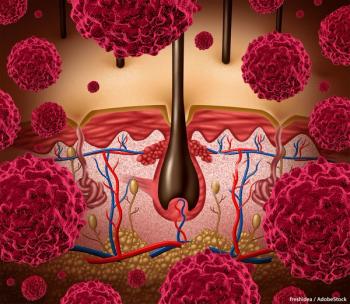
Is Race Associated With Clinical Differences in Melanoma?
Study authors evaluated clinically relevant differences in nonwhite vs white pediatric patients with melanoma and atypical melanocytic neoplasms.
Clinically relevant differences are present in nonwhite vs white children, adolescents, and young adults diagnosed with melanoma and atypical melanocytic neoplasms, according to the results of a long-term prospective study
“Atypical melanocytic lesions and melanoma are challenging to diagnose. Fortunately, they are rare, but rarity contributes to the challenges in diagnosis and management,” said
Subjects included in the current study were younger than age 25 years and were followed 1995 to 2018. The researchers assessed for differences in clinical presentation, including the following: skin phototype, race/ethnicity, age, sex, tumor/melanoma characteristics, and outcome. In total, 17 of 55 patients were nonwhite (skin phototype IV; 9 men), including Asians, Hispanics, or blacks. Median follow-up was 36 months.
The investigators diagnosed melanomas in 87% of whites vs 65% of nonwhites. The remainder of the tumors were mostly atypical Spitz tumors.
Compared with whites, nonwhites presented at a younger mean age (10.9 years vs 15.4 years; P < .05). Additionally, nonwhites were more likely to present with pink/clinically amelanotic tumors (59% vs 24%; P = .02).
“Clinicians should have a high index of suspicion when evaluating amelanotic lesions in children. In nonwhite children in this study, tumors-atypical lesions and melanoma-were more common on the extremities and most often noticed by the patient or a family member,” said Coughlin. “They were more likely to be amelanotic than in white patients. These facts can aid in evaluation of these lesions.”
However, Coughlin pointed out that the study had limitations. “The authors provide a list of the ancillary testing they used to help classify lesions, but do not show the results of the testing nor lay out fully how the results contributed to their final diagnoses,” she said.
The current study is similar to others that were recently published. “A recent study by Bartenstein et al. (Clinical features and outcomes of spitzoid proliferations in children and adolescents. Br J Dermatol. 2018 Nov 22 [epub ahead of print]) included 110 patients with atypical spitzoid lesions and melanoma, as well as 522 with typical Spitz nevi, but was missing race data for 35% of the cohort,” said Coughlin. “Only 3 of their patients had melanoma, which is far less than included in Afanasiev et al’s cohort.”
Looking forward, Coughlin anticipates further research on the topic. “Further study on location and presentation of pediatric melanoma, with integration of staining patterns and molecular testing, is needed,” she said. “In addition, a search for more refined prognostic factors would greatly aid the management of these patients.”
Newsletter
Stay up to date on recent advances in the multidisciplinary approach to cancer.


















































































